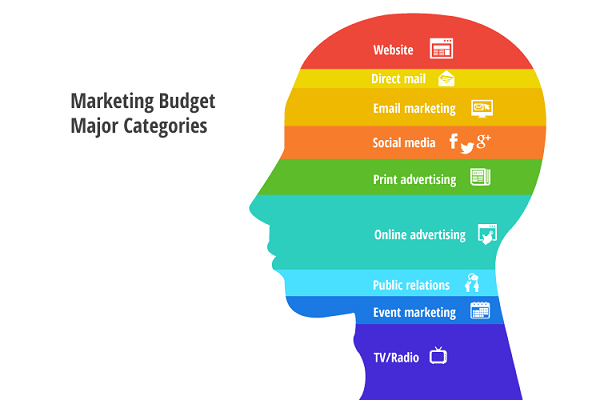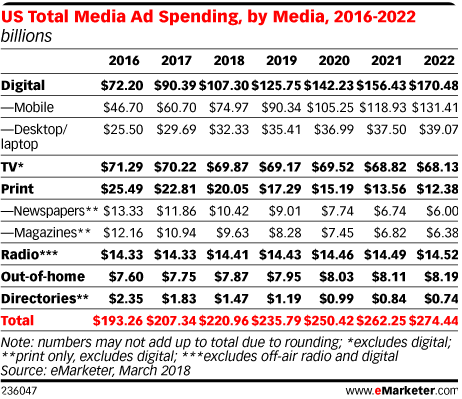Marketing Budgets Explained: Even Your Kids Could Do It
How much should I spend on marketing each year to grow my company?
by Alyssa Rice
Executive Summary
Young, fast-growing, and online companies will often spend 10 – 20% of their annual revenues on marketing activities.
Mature, conventional, large companies will often spend 4 – 8% of their annual revenues on marketing activities.
An average of all companies suggests that companies spend about 8-10% of their annual revenues on marketing activities.
You may be a business owner deciding how much you want to spend on advertising or an employee in a marketing department planning to pitch your proposed budget to senior management. Either way, it can be good to know how your spending compares with other companies and industries.
We all want to hit that sweet spot where we optimize our marketing spend. It can be hard to determine this, so here are some rules of thumb that have shown success.
The Budget
On average, marketing budgets make up around 10% of a company’s total budget. The U.S. Small Business Administration suggests that if your company makes more than $5 million per year, 7-8% of your revenue should go towards your marketing budget.
The first thing you should look at when deciding on a budget is your company’s gross revenue. If you are a small and new company, your budget should be between 10%-20% of your gross revenue. You need to establish your brand and name recognition, so spending a higher percentage is key.
At the other end of the spectrum, if you are an older and more established company, you can spend around 5%-11% because you will likely already be known in the industry.
Note that online ecommerce-type companies almost come in at the high end of marketing spending. Conversely, traditional manufacturing, industrial and conventional types of companies often focus on sales and client relationships (service) over marketing, and thus come in at the low end for their annual marketing budgets.
Where to Spend Your Dollars

There are many, many different avenues to spend your marketing budget, such as your website, email marketing, branding, lead purchases, events, webinars, public relations, sponsorships, print ads, trade shows, link building, influencers, and of course social media.
A New World, A New Budget
For many companies today, for many reasons, most of your budget will go to some aspect of digital marketing. According to HubSpot, digital marketing is “all marketing efforts that use an electronic device or the Internet.”
Digital marketing will encompass email marketing, search engines, search engine optimization (SEO), social media, email, web site development, electronic storefronts, shopping carts, virtual trade shows, webinars, and more.
The table above shows the U.S.’ total media spending in different categories for a span of six years. As you can see, digital forms have increased every year, while TV, print, and directories have shown a decrease.
One reason that digital marketing is the preferred channel for your marketing efforts is that almost all activities are measurable. You can easily track the number of unique visitors to your web site, the opens and clicks on your latest email marketing campaign, and the number of clicks you get from a Google Ad. With offline marketing such as a billboard or radio advertisement, it can be very difficult to gauge effectiveness.
Another reason that digital marketing is so effective is the ease of deployment and ability to increase, change, or turn off campaigns. Web site pages can be easily changed. Prices and offers can be adjusted. And if needed, campaigns can easily be paused or suspended.
If you add up all of your other marketing costs and compare it to digital marketing, digital marketing is significantly less expensive. Compared to pricey billboards, print advertisements, direct mail, and event marketing, digital marketing is a lot better for your wallet.
Offerings like Google Ads, WordPress, and social media planning tools like Buffer and Hootsuite can help you plan and spend wisely to build your online assets and then promote them effectively.
Marketing investments factor directly into cost per acquisition (CPA) of a new customer. Spend too much to get a customer, and you lose money (in the short term anyway). Spend very little money to get a new customer, and it can be a wonderful thing, as long as you can service that customer profitably.
Many young promising companies that are venture-capital backed with growth capital (money from investors) will run for many months or even years at a loss (called runway) in order to acquire customers and eventually get profitable. They spend huge amounts of money in marketing to acquire new customers.
Companies in SaaS (software as a service), a very strong business model, looking to grow aggressively will sometimes spend more than 100% of their annual revenues in sales and marketing when they feel confident that the company has a potential for explosive growth and marketplace disruption. See chart on this web page which shows a financial model for a SaaS startup: https://tomtunguz.com/sales-marketing-spend-model/.
A Seismic Shift in Sales and MarketingMany people now believe that the buyer is in control of the sales / purchase process. At one time a high-powered sales staff was required for success. But things are a bit different now. Simply put, business is done differently.
Modern marketing approaches involve a series of touches or interactions between the prospect (buyer) and the company (seller). As the buyer moves through the sales funnel and goes deeper and further into a relationship with the company, the buyer’s perceived value or score is higher. Some marketing automation programs use sophisticated methods to score and rank a company’s hottest and most-likely-to-buy prospects.
Here’s how it works in a B2B example: A prospect does a web search. Prospect goes to seller’s web site. Prospect either signs up for email newsletter, or downloads a special report whitepaper. Two weeks pass. Seller sends prospect an email with invitation for a free trial, or free online demo. Prospect takes the free two week trial. Etc.
So, as you can see, this activity is ALL marketing related. It moves the prospect along. It “nurtures” the relationship and builds trust and reliability. It is predictable. The formula works.
There is no trade show. There is no sales call. There is no office visit from a regional sales representative who happens to be “in the area.” There are no endless voice mails left on the prospects voice mail.
Digital marketing is how buyers like to learn about, research, try out, evaluate, and decide on purchases. It’s buying on their terms, in their own way, with the buyer in control. The larger and more impactful the purchase, the more importance that a marketing process is followed in order to build trust and confidence.
Of course if the purchase is highly technical or needs a lot of education around the product or service, a thoughtful sales effort is needed. This educational needs-analysis process works even better if the company can offer a Sales Engineer or Customer Success Manager to answer questions and help onboard the new customer in a much more accommodative way. This can be a superior non-threatening way to help the prospect decide to buy from you.
How to Pitch Your BudgetIf you are a marketer within a company, you probably have to pitch your budget yearly, and justify your spending. You have to ask yourself, How do I explain how important my proposed initiatives are? .
When pitching, you need to focus on the what, why, and how much. Pick out what you want to spend money on, what the ROI is, and how much it will cost. This will give the budget approver exactly what they need from you. Support your reasoning with data. Keep it short, sweet, to the point, while pitching the crucial information.
It may be helpful to you to know what you would remove from the budget and what you would add to the budget. Your company could have extra funds to add to your budget, or need to decrease your budget. This will show the budget approver that you are prepared and have thought through your plan.
Use this Downloadable Marketing Budget Template from the non-profit SCORE to help you plan.
What Time of Year to Spend the Most
Most departments receive new budgets in the beginning of a fiscal year, and many companies use the calendar year as their fiscal year. Companies will try new promotions, offers, pricing, vendors, and other marketing approaches at the beginning of the year, quarter, or month.
We’ve noticed that the new year starting in January often brings about a whole new energy and interest in starting the new year fresh, with lots of optimism. Marketing departments of all kinds look for new ways to gain exposure, purchase advertising, send emails campaigns, and coordinate their social media efforts. What new tactics and approaches can you use that you may not have tried before?
Conclusion
Set your marketing budget, measure the impact, and reevaluate periodically. Find what works for your organization. As long as you set defined goals and milestones, and follow a plan to execute your strategy, your budgeting process will be the kick-off to a new season of marketing success for you and your organization.
ResourcesDownloadable Marketing Budget Template - https://www.score.org/resource/annual-marketing-budget-template
9 Reasons Why You Need Marketing: - https://www.business2community.com/marketing/why-is-marketing-important-9-reasons-why-you-really-do-need-it-02186221
Why You Should Keep Marketing in Tough Times - https://blog.netatlantic.com/2020/06/23/keep-marketing-in-economic-tough-times/



